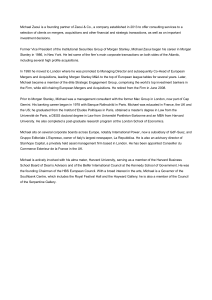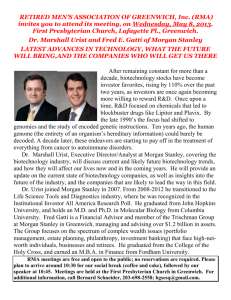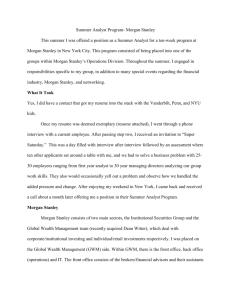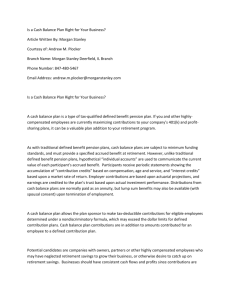Other Important Disclosures
advertisement
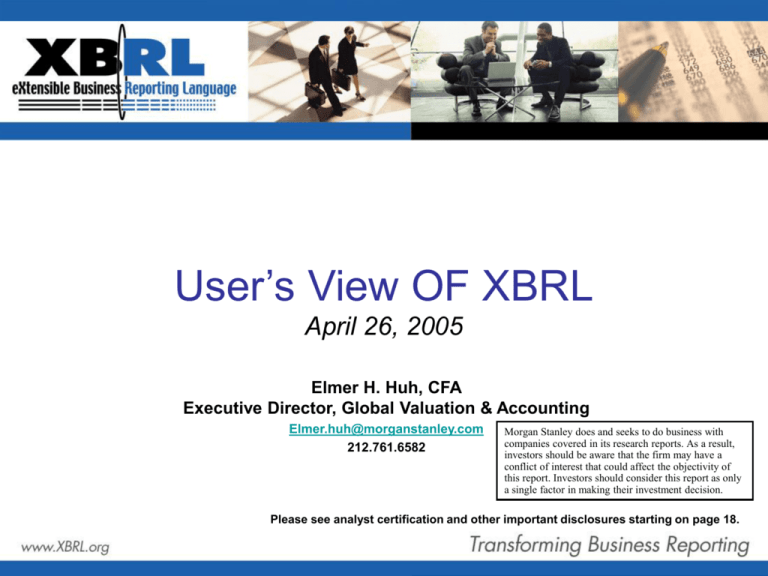
User’s View OF XBRL April 26, 2005 Elmer H. Huh, CFA Executive Director, Global Valuation & Accounting Elmer.huh@morganstanley.com 212.761.6582 Morgan Stanley does and seeks to do business with companies covered in its research reports. As a result, investors should be aware that the firm may have a conflict of interest that could affect the objectivity of this report. Investors should consider this report as only a single factor in making their investment decision. Please see analyst certification and other important disclosures starting on page 18. 2 Contents Elmer H. Huh, CFA Executive Director Morgan Stanley Equity Research Elmer.Huh@morganstanley.com 212.761.6582 XBRL for Financial Analysis Updating Financial Models Comparing Financial Information Simplifying Complex Information Summary and Conclusions Please see analyst certification and other important disclosures starting on page 18. 3 XBRL for Financial Analysis Can help facilitate the comparability and granularity of financial disclosure Can help make the analysis timely and transparent Can help simplify some aspects of the analysis of complex financial reporting Please see analyst certification and other important disclosures starting on page 18. Source: Morgan Stanley Research; company reports 4 XBRL: A major advance in financial reporting HTML or PDF renditions of reports only exploit the ease of distribution that the Internet offers In practice they are of little more value than a photocopied press release XBRL will allow accurate, relevant, scalable querying of financial information Conclusion: Complex information can be turned into simple knowledge! Please see analyst certification and other important disclosures starting on page 18. 5 What Lies Ahead? Analysis 2004: “e-Analysis” Fundamental Analysis and Consistency Analysts Company B Company A Regulatory Filings ISP 10K Wizard XBRL EdgarPro Integrated Models •Multiperiod estimates •Risk profiles •Management assessments … Management Reports Economic Supply Chain XBRL Customers Source: Morgan Stanley Research Investors Internet Data Purveyors Please see analyst certification and other important disclosures starting on page 18. 6 Use Case: Updating Financial Models Quick Comments Immediate response to earnings releases Time pressure restricts the level of analysis Detailed Analyses More detailed analysis of filings Routine reports should be easier to complete Source: Morgan Stanley Research Please see analyst certification and other important disclosures starting on page 18. 7 Workflow: Updating Financial Models Current Workflow Report published to the web in HTML or PDF format Analyst manually transcribes numbers into spreadsheet model and… …analyses results quickly in order to get a comment out Process with XBRL Report published in XBRL format Numbers automatically loaded into spreadsheet by an Excel add-in Analyst has more time to analyse results with confidence Please see analyst certification and other important disclosures starting on page 18. 8 Use Case: Sorting through the Disclosure Example: Obligation Disclosure Recommended by the SEC Payments Due by Period Contractual Obligations Total Less than 1 year 1-3 years 4-5 years After 5 years Long-Term Debt Capital Lease Obligations Operating Leases Unconditional Purchase Obligations Other Long-Term Obligations Total Contractual Cash Obligations Source: Securities and Exchange Commission, Release Nos. 33-8056; 34-45321; FR, "Commission Statement about Management's Discussion and Analysis of Financial Condition and Results of Operations”; “Big Forest, Lots of Trees” February 12, 2002 Please see analyst certification and other important disclosures starting on page 18. 9 Operating Leases: What is real debt/credit risk? 16,000 14,000 Millions of $USD 12,000 10,000 8,000 6,000 4,000 2,000 (2,000) Winn Dixie Stores FedEx Corp. UPS Estimated Net Reported Debt Sources: Company reports, Morgan Stanley Research Walgreens Deutsche Post World Net Cathay Pacific Airways Net Debt including Operating Leases Available in ModelWare Please see analyst certification and other important disclosures starting on page 18. 10 Impact on Earnings From Pensions: GM Reported Cost GM US Pension Plans Net Financing Cost 4,000 $USD Millions 2,000 - (2,000) Operating (4,000) Cost (6,000) Actual Cash Flow (8,000) 1999 Reported Cost "Cash " Contribution 2000 2002 numbers have been restated to reflect results of Hughes as discontinued operations Source: Morgan Stanley Research estimates; Company reports 2001 Operating Cost Benefits Paid to Retirees 2002 2003 Net Financing Benefit (Cost) $(18.6) bn Available in ModelWare Please see analyst certification and other important disclosures starting on page 18. 11 OPEB Benefit Cost per US Unit Autos (1,000) $USD Millions (2,000) (3,000) (4,000) (5,000) (6,000) (7,000) 1999 Reported Cost "Cash " Contribution 2000 2001 2002 Operating Cost Benefits Paid to Retirees 2002 GM Benefits paid to retirees per car Reported expense in operating costs per car Cash paid by GM per car Ford Benefits paid to retirees per car Reported expense in operating costs per car Cash paid by GM per car $ $ 2003 Net Financing Benefit (Cost) 2001 (835) $ (857) $ (1,011) (1,005) (1,081) (506) (361) $ (622) (389) (358) $ (601) (166) 2000 1999 (664) $ (751) (667) (527) (656) (863) (281) $ (413) (622) (202) (329) (337) Source: Morgan Stanley Research estimates; Company reports; NAM – North America Please see analyst certification and other important disclosures starting on page 18. 12 Use Case: Comparing Financial Information Very detailed comparisons In-depth analysis of specific areas of company financials Frequency of reports limited by time to collate Very broad thematic reports Key report for investors on market-wide issues Number of companies included restricted by time Source: Morgan Stanley Research Please see analyst certification and other important disclosures starting on page 18. 13 Workflow: Comparing Financial Information Current Workflow Comparable data are sourced from separate financial reports Data must be checked to ensure it is complete and comparable More time is spent on collation and verification than on analysis Process with XBRL Query submitted to XBRL data aggregator Results returned effectively immediately More time to analyse more companies Please see analyst certification and other important disclosures starting on page 18. 14 Non-Performing Loans: A Comparison of Varying Treatments Hong Kong ≥ 90 days past due. Man-agement discretion permitted. Conservative bias. Japan ≥ 90 days past due. Man-agement discretion per-mitted. Korea ≥ 90 days past due. Management discretion permitted. Singapore ≥ 90 days past due. Conservative bias. Basis of Loan Classifications Substandard: 0-3 mo. PD. Doubtful: 3-12 mo. PD. Loss: 12 mo. PD or no recovery expected. Substandard: >= 90 days (including those between 90 and 180 days; Doubtful: 180 days past due Bankrupt / Quasi Bankrupt: no recovery expected. Classifications are based on management discretion. Reflect optimistic bias, individual bank differences. Categories: Precautionary, Substandard, Doubtful, and Loss. Pass/Special Mention, Substandard (secured, not fully secured, loss), Doubtful and Loss. Conservative bias. Provisioning Methodology No formal guideline. Informal guidelines: 3 mo. PD → 25% provision; 6 mo. PD → 50% provision; 12 mo. PD → 100% provision.[Are these percentages net of collateral?] Provisioning closely tied to loan classification but no formal guidelines; Normal: 0.5% of loans. Special Mention: 15%-25%. Substandard: 25%-35%. Doubtful: 70%. Loss: 100%. Normal: 0.5% of loans.Precautionary: 2%. Substandard: 20%.Doubtful: 50%. Loss: 100%.[Gross or net of collateral?] Pass/Special Mention: 1%. Substandard: secured, 0% of principal, 100% of interest;not fully secured, 10-50% of collateral shortfall; loss, 100% of collateral shortfall. Doubtful: 50100% of loans. Loss: 100%. Definition Conclusion: Treatment varies and complicates comparability Source: Morgan Stanley Research, Company Reports Please see analyst certification and other important disclosures starting on page 18. 15 Why XBRL will improve financial analysis Accuracy Greater confidence in numbers used for analysis Reliable results in higher quality conclusions Timeliness More time to focus on analysis, not process Shorter “time to market” More frequent high-quality analysis Please see analyst certification and other important disclosures starting on page 18. 16 Other points to consider Research model changing Information and Knowledge are two separate things Numbers aren’t everything; context matters too We need more companies to report using XBRL We need software tools to be able to manipulate XBRL Please see analyst certification and other important disclosures starting on page 18. 17 Conclusions XBRL will improve the relevance and quality of financial analysis Stocks with higher corporate governance standards have outperformed 180 Companies should look at XBRL as a way to improve communication with their stakeholders GMI “Top 26” 160 140 S&P 500 120 100 Greater transparency results in a lower cost of capital! 80 1999 2000 2001 2002 2003 2004 Source: Governance Metrics International Please see analyst certification and other important disclosures starting on page 18. 18 Important Disclosures Analyst Certification The following analysts hereby certify that their views about the companies and their securities discussed in this report are accurately expressed and that they have not received and will not receive direct or indirect compensation in exchange for expressing specific recommendations or views in this report: Elmer Huh. Important US Regulatory Disclosures on Subject Companies The information and opinions in this report were prepared by Morgan Stanley & Co. Incorporated and its affiliates (collectively, "Morgan Stanley"). The research analysts, strategists, or research associates principally responsible for the preparation of this research report have received compensation based upon various factors, including quality of research, investor client feedback, stock picking, competitive factors, firm revenues and overall investment banking revenues. Please see analyst certification and other important disclosures starting on page 18. 19 Ratings Distribution and Definitions Global Stock Ratings Distribution (as of Mar 31, 2005) Coverage Universe Investment Banking Clients (IBC) Stock Rating Category Overweight/Buy % of % of Count Total Count 669 35% 267 Total IBC % of Rating Category 40% 40% Equal-weight/Hold 868 45% 299 45% 34% Underweight/Sell 19% 105 16% 28% Total 371 1,908 671 Data include common stock and ADRs currently assigned ratings. For disclosure purposes (in accordance with NASD and NYSE requirements), we note that Overweight, our most positive stock rating, most closely corresponds to a buy recommendation; Equal-weight and Underweight most closely correspond to neutral and sell recommendations, respectively. However, Overweight, Equal-weight, and Underweight are not the equivalent of buy, neutral, and sell but represent recommended relative weightings (see definitions below). An investor's decision to buy or sell a stock should depend on individual circumstances (such as the investor's existing holdings) and other considerations. Investment Banking Clients are companies from whom Morgan Stanley or an affiliate received investment banking compensation in the last 12 months. Analyst Stock Ratings Overweight (O or Over) - The stock's total return is expected to exceed the average total return of the analyst's industry (or industry team's) coverage universe, on a risk-adjusted basis over the next 12-18 months. Equal-weight (E or Equal) - The stock's total return is expected to be in line with the average total return of the analyst's industry (or industry team's) coverage universe, on a risk-adjusted basis over the next 12-18 months. Underweight (U or Under) - The stock's total return is expected to be below the average total return of the analyst's industry (or industry team's) coverage universe, on a risk-adjusted basis, over the next 12-18 months. More volatile (V) - We estimate that this stock has more than a 25% chance of a price move (up or down) of more than 25% in a month, based on a quantitative assessment of historical data, or in the analyst's view, it is likely to become materially more volatile over the next 1-12 months compared with the past three years. Stocks with less than one year of trading history are automatically rated as more volatile (unless otherwise noted). We note that securities that we do not currently consider "more volatile" can still perform in that manner. Unless otherwise specified, the time frame for price targets included in this report is 12 to 18 months. Ratings prior to March 18, 2002: SB=Strong Buy; OP=Outperform; N=Neutral; UP=Underperform. For definitions, please go to www.morganstanley.com/companycharts. Analyst Industry Views Attractive (A) - The analyst expects the performance of his or her industry coverage universe to be attractive versus the relevant broad market benchmark over the next 12-18 months. In-Line (I) - The analyst expects the performance of his or her industry coverage universe to be in line with the relevant broad market benchmark over the next 12-18 months. Cautious (C) - The analyst views the performance of his or her industry coverage universe with caution versus the relevant broad market benchmark over the next 12-18 months. Stock price charts and rating histories for companies discussed in this report are available at http://www.morganstanley.com/companycharts. You may also request this information by writing to Morgan Stanley at 1585 Broadway, 14th Floor (Attention: Research Disclosures), New York, NY, 10036 USA. Please see analyst certification and other important disclosures starting on page 18. 20 Other Important Disclosures This research report has been published in accordance with our conflict management policy, which is available at www.morganstanley.com/institutional/research/conflictpolicies. For a discussion, if applicable, of the valuation methods used to determine the price targets included in this summary and the risks related to achieving these targets, please refer to the latest relevant published research on these stocks. Research is available through your sales representative or on Client Link at www.morganstanley.com and other electronic systems. This report does not provide individually tailored investment advice. It has been prepared without regard to the individual financial circumstances and objectives of persons who receive it. The securities discussed in this report may not be suitable for all investors. Morgan Stanley recommends that investors independently evaluate particular investments and strategies, and encourages investors to seek the advice of a financial adviser. The appropriateness of a particular investment or strategy will depend on an investor's individual circumstances and objectives. This report is not an offer to buy or sell any security or to participate in any trading strategy. In addition to any holdings disclosed in the section entitled "Important US Regulatory Disclosures on Subject Companies", Morgan Stanley and/or its employees not involved in the preparation of this report may have investments in securities or derivatives of securities of companies mentioned in this report, and may trade them in ways different from those discussed in this report. Derivatives may be issued by Morgan Stanley or associated persons. Morgan Stanley & Co. Incorporated and its affiliate companies do business that relates to companies covered in its research reports, including market making and specialized trading, risk arbitrage and other proprietary trading, fund management, investment services and investment banking. Morgan Stanley sells to and buys from customers the equity securities of companies covered in its research reports on a principal basis. Morgan Stanley makes every effort to use reliable, comprehensive information, but we make no representation that it is accurate or complete. We have no obligation to tell you when opinions or information in this report change apart from when we intend to discontinue research coverage of a subject company. With the exception of information regarding Morgan Stanley, reports prepared by Morgan Stanley Research personnel are based on public information. Facts and views presented in this report have not been reviewed by, and may not reflect information known to, professionals in other Morgan Stanley business areas, including investment banking personnel. Morgan Stanley Research personnel conduct site visits from time to time but are prohibited from accepting payment or reimbursement by the company of travel expenses for such visits. The value of and income from your investments may vary because of changes in interest rates or foreign exchange rates, securities prices or market indexes, operational or financial conditions of companies or other factors. There may be time limitations on the exercise of options or other rights in your securities transactions. Past performance is not necessarily a guide to future performance. Estimates of future performance are based on assumptions that may not be realized. This publication is disseminated in Japan by Morgan Stanley Japan Limited; in Hong Kong by Morgan Stanley Dean Witter Asia Limited; in Singapore by Morgan Stanley Dean Witter Asia (Singapore) Pte. (Registration number 199206298Z) and/or Morgan Stanley Asia (Singapore) Securities Pte Ltd (Registration number 200008434H), regulated by the Monetary Authority of Singapore, which accepts responsibility for its contents; in Australia by Morgan Stanley Dean Witter Australia Limited A.B.N. 67 003 734 576, holder of Australian financial services licence No. 233742, which accepts responsibility for its contents; in Taiwan by Morgan Stanley & Co. International Limited, Taipei Branch; in Korea by Morgan Stanley & Co. International Limited, Seoul Branch; in India by JM Morgan Stanley Securities Private Limited; in Canada by Morgan Stanley Canada Limited, which has approved of, and has agreed to take responsibility for, the contents of this publication in Canada; in Spain by Morgan Stanley, S.V., S.A., a Morgan Stanley group company, which is supervised by the Spanish Securities Markets Commission (CNMV) and states that this document has been written and distributed in accordance with the rules of conduct applicable to financial research as established under Spanish regulations; in the United States by Morgan Stanley & Co. Incorporated and Morgan Stanley DW Inc., which accept responsibility for its contents. Morgan Stanley & Co. International Limited, authorized and regulated by Financial Services Authority, disseminates in the UK research that it has prepared, and approves solely for the purposes of section 21 of the Financial Services and Markets Act 2000, research which has been prepared by any of its affiliates. Private U.K. investors should obtain the advice of their Morgan Stanley & Co. International Limited representative about the investments concerned. In Australia, this report, and any access to it, is intended only for "wholesale clients" within the meaning of the Australian Corporations Act. The trademarks and service marks contained herein are the property of their respective owners. Third-party data providers make no warranties or representations of any kind relating to the accuracy, completeness, or timeliness of the data they provide and shall not have liability for any damages of any kind relating to such data. The Global Industry Classification Standard ("GICS") was developed by and is the exclusive property of MSCI and S&P. This report or any portion hereof may not be reprinted, sold or redistributed without the written consent of Morgan Stanley. Morgan Stanley Research is disseminated and available primarily electronically, and, in some cases, in printed form. Additional information on recommended securities is available on request. 2005 Copyright Morgan Stanley Please see analyst certification and other important disclosures starting on page 18.

